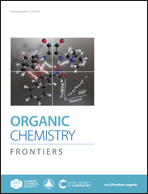An unusual reaction mode of 1-phenylpyrazolidinones toward diazonaphthalen-2(1H)-ones featuring cascade C(sp2)–H and C(sp3)–H bond cleavage†
Abstract
Herein, a novel synthesis of pyrazolidinone fused 1,3-benzooxazepine derivatives via a formal [4 + 3] annulation reaction of 1-phenylpyrazolidinones with diazonaphthalen-2(1H)-ones is presented. Mechanistically, the formation of products involves an unprecedented reaction mode of 1-phenylpyrazolidinone featuring cascade C-alkylation/C-annulation through C(sp2)–H/C(sp3)–H bond cleavage instead of C-alkylation/N-annulation via C(sp2)–H/N–H bond cleavage as reported in previous studies on the reaction of 1-phenylpyrazolidinone. In this cascade process, the pyrazolidinone unit firstly acts as an embedded directing group to assist in the alkylation and subsequently it is transformed into a cyclic iminium species to undergo an intramolecular nucleophilic addition with the in situ formed naphthol unit to give the polycyclic product. Compared with literature methods for the preparation of N-fused 1,3-oxazepines, the protocol developed herein has advantages such as easily accessible starting materials, structurally complex and biologically attractive products, a unique mechanistic pathway, and excellent chemo/regioselectivity.

- This article is part of the themed collection: 2021 Organic Chemistry Frontiers HOT articles


 Please wait while we load your content...
Please wait while we load your content...